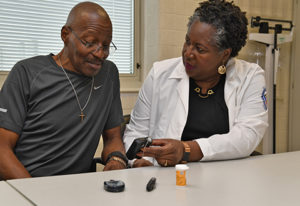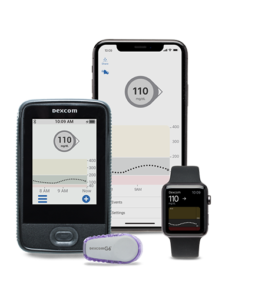
The Ralph H. Johnson VA Medical Center Diabetes Self-Management Education Service (DSMES) located at the main hospital in downtown Charleston, SC, has been awarded continued Recognition from the American Diabetes Association. Here, diabetes educator Cheryl Pratt instructs veteran Dewayne Patterson how to use of his insulin pump. Photo by James Arrowood is on the VA website.
BOSTON, MA — The VA’s new prescribing guidance for continuous glucose monitors significantly expands the number of veterans with diabetes who are eligible for the devices. That could be good news for thousands of current and former servicemembers tired of pricking their fingers several times a day.
The VA cares for 1.6 million veterans with diabetes, which is about 25% of all the veterans enrolled in its healthcare system. Of those, half a million are treated with insulin, according to Paul Conlin, MD, chief of medical service at the VA Boston Healthcare System. Most diabetes patients who use insulin check their blood glucose levels several times a day, a procedure that requires drawing blood via fingerstick.
Continuous glucose monitors offer a less painful and more timely alternative. The monitors are small devices that are typically worn on the abdomen or upper arm. They have a tiny sensor wire that stays under the skin to measure glucose concentrations in the body’s interstitial fluid. Real-time CGMs measure glucose at regular intervals around the clock and have a transmitter connected to the sensor that sends the readings to a receiver or mobile device app where the user can see current glucose levels as well as trends. Real-time CGMs also provide alerts and alarms to let the wearer and, in some cases, caregivers, know if their blood glucose is headed in a dangerous direction.
Intermittently scanned CGMs require the user to scan the sensor to see their glucose levels. They do not have alarms or alerts and typically require regular recalibration by checking results against fingerstick readings.
Continuous glucose monitors provide substantially more information for patients and providers to manage diabetes. “It has given us a snapshot into their lives that we have never seen before. They can get some of this data from doing fingersticks but it’s just a couple of points in the day whereas with a continuous glucose monitor they have it literally at their fingertips whenever they want it,” said Alicia Warnock, MD, former director of the Diabetes Institute at Walter Reed National Military Medical Center and U.S. Navy physician, and current Chief Operating Officer of Stability Health in Worcester, Mass.
New VA Rules
To qualify for a continuous glucose monitor, veterans with diabetes must require three or more insulin injections daily and four or more blood glucose level checks per day. In addition, veterans must have the skills to operate a CGM and agree to healthcare visits at least every six months to evaluate their use of the device and their diabetes.
Not everyone who meets those main criteria will qualify, however. The VA also requires a demonstrated risk of hypoglycemia, combined with trouble controlling their blood glucose levels, despite adherence to recommended therapy. Alternatively, individuals whose work environment poses a risk of harm if they experienced a hypoglycemic event and those who have difficulty self-monitoring blood glucose levels as a result of disability or disease may also qualify for a CGM under the new program.
The expanded access aligns with the recommendations of the International Consensus of Use of Continuous Glucose Monitoring. Those say that “CGM should be considered in conjunction with HbA1c for glycemic status assessment and therapy adjustment in all patients with type 1 diabetes and patients with type 2 diabetes treated with intensive insulin therapy who are not achieving glucose targets, especially if the patient is experiencing problematic hypoglycemia.”
New Partnerships
 In addition to covering use of continuous glucose monitors for a wider group of veterans, the VA has made it quicker and easier for veterans prescribed the devices to obtain them. Previously, prescriptions for Dexcom’s G6 CGM were filled through the Durable Medical Equipment channel, which slowed access. Now, the entire monitoring system can be obtained through the pharmacy and, for qualifying veterans, at no cost.
In addition to covering use of continuous glucose monitors for a wider group of veterans, the VA has made it quicker and easier for veterans prescribed the devices to obtain them. Previously, prescriptions for Dexcom’s G6 CGM were filled through the Durable Medical Equipment channel, which slowed access. Now, the entire monitoring system can be obtained through the pharmacy and, for qualifying veterans, at no cost.
The changes are already being noticed by veterans. “It’s gone from taking months to get my first device ready to go to getting a refill in less than a week,” Leaha Worthington, a Navy veteran in Temple, TX, told U.S. Medicine. “Before I had to get the transmitter from prosthetics and the sensor from the pharmacy and it took two months. Now I get the sensor pads and [sensor] that goes under the skin every 10 days. The system is definitely becoming more streamlined.”
“Easier access to CGM at the pharmacy is a big win for veterans with diabetes. Research continues to show CGM should be the standard of care for any diabetes patient on intensive insulin therapy,” said Dhiren Patel, PharmD, a clinical pharmacy specialist and certified diabetes educator at the VA Boston Healthcare System, associate professor of Pharmacy Practice at the Massachusetts College of Pharmacy and Health Sciences in Boston, and associate professor of Pharmacology at the Alpert Medical School of Brown University in Providence, RI. “Dexcom G6 has a number of highly beneficial features including predictive low alerts to help avoid dangerous low blood sugar events, time-in-range reports, and remote monitoring capabilities that allow patients to share their glucose data in real time with up to 10 followers.”
Other manufacturers of CGMs are also engaging with veterans to help them understand how to access the monitors and take control of their diabetes, as access for different systems may be through different channels. An implantable CGM, for instance, is procured through the prosthetics rather than pharmacy channels.
There are several options available, so veterans are likely to find a continuous glucose monitor that works for them and their lifestyle. “If patients are wondering if CGM is the right device for them, I would encourage them to become their own advocate for their health,” said Warnock. “Read about it, find out as much as you can, but then come to your doctor with that information and ask them the question. Tell them what you’ve learned about CGM, what you don’t know about CGM, and what struggles you’re having taking care of your diabetes.”

